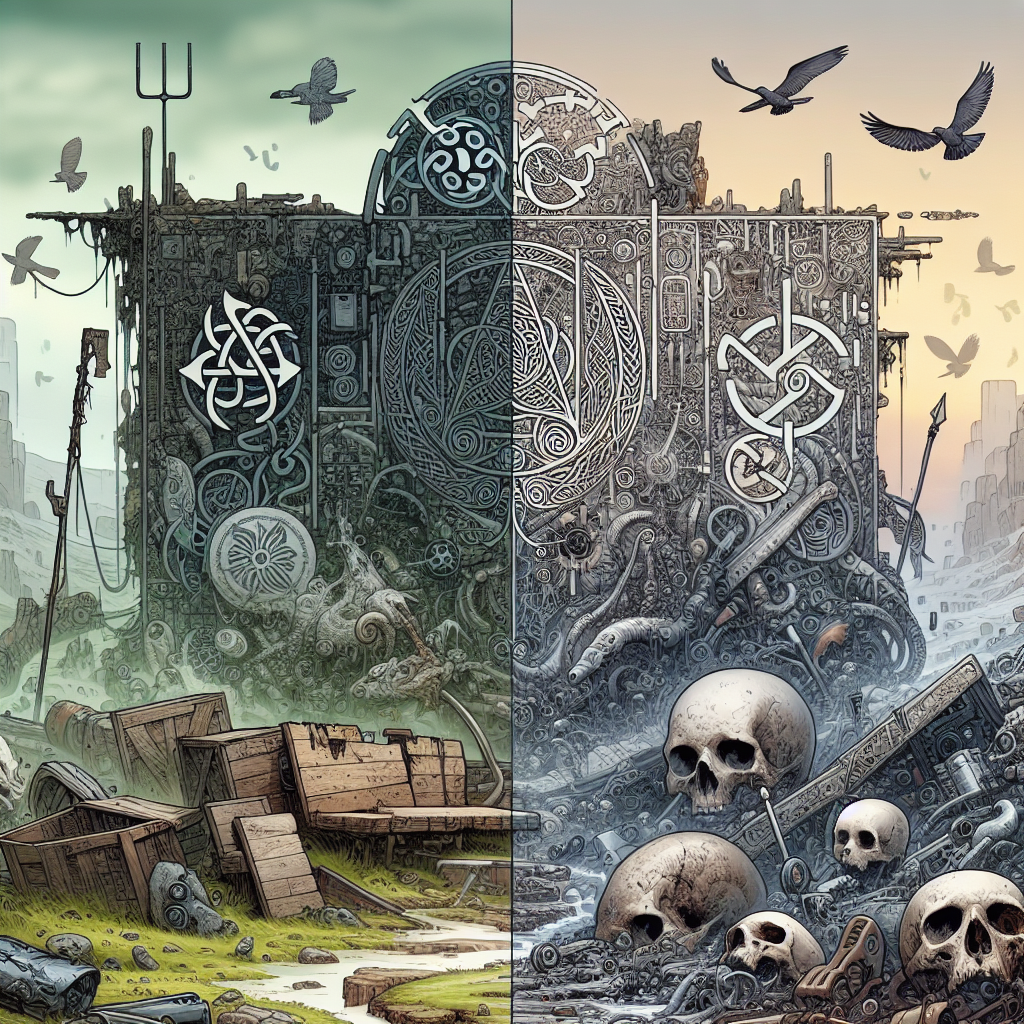In the realm of afterlife theories, there exists a distinction between ghosts and spirits, despite the frequent use of these terms interchangeably. Ghosts are manifestations of human energy, often stuck in a particular location and unaware that they are dead. On the other hand, spirits are the souls of deceased beings who have passed on, aware and active, able to interact with humans and the physical environment. It is important to understand the difference between ghosts and spirits to navigate their presence in various contexts and establish boundaries.
Key Takeaways:
- Ghosts are manifestations of human energy, while spirits are the souls of deceased beings who have passed on.
- Ghosts often remain stuck in specific locations, unaware of their deceased state, while spirits are aware and can actively interact with both humans and the physical world.
- Ghosts are associated with haunting and often have unfinished business, while spirits have the freedom to move between dimensions and may even visit their loved ones.
- While ghosts are often associated with negative or haunting motives, spirits can choose to act out of love or fear.
- Understanding the differences between ghosts and spirits helps us navigate their presence and establish boundaries in dealing with them.
Ghosts: Manifestations of Human Energy
Within the realm of afterlife theories, ghosts are believed to be manifestations of human energy, lingering in specific locations and often unaware of their deceased state. These ethereal beings are commonly associated with haunted places and paranormal activities.
Ghosts are thought to be trapped in a state of limbo, unable to move on from their earthly existence. They are believed to remain tied to the location where they passed away or experienced a significant event. This attachment to a specific place is what often leads to their association with haunted houses and other eerie settings.
Haunted places are said to be imbued with the energy of these lost souls, resulting in paranormal activities such as unexplained sounds, apparitions, and strange phenomena. Ghosts may interact with their surroundings by moving objects, creating cold spots, or emitting eerie sounds, providing a tangible presence to their ethereal existence.
| Ghosts: Manifestations of Human Energy |
|---|
| – Lingering energy tied to specific locations – Often unaware of their deceased state – Associated with haunted places and paranormal activities |
The Haunting Mystery
“The existence of ghosts and their connection to haunted places has always fascinated individuals, enticing them to explore the mysteries of the afterlife.” – Paranormal Investigator
Hauntings have captured the imagination of people throughout history, with numerous accounts and stories passed down through generations. The presence of ghosts in these narratives often adds a sense of mystery and intrigue to the tales, as they represent a bridge between the living and the realm beyond.
While ghosts are often associated with fear and apprehension due to their connection to the unknown, they also provide an opportunity for further exploration and understanding of what lies beyond our mortal existence.
By recognizing the role of ghosts as manifestations of human energy in afterlife theories, we can engage with the mysterious world of the supernatural and gain a deeper appreciation for the complexities of life and death.
In this section you should finish the text with closing
tag and add a few key points for the readers.Key Points:
- Ghosts are manifestations of human energy lingering in specific locations.
- They are often unaware of their deceased state.
- Ghosts are associated with haunted places and paranormal activities.
- They offer a gateway to explore the mysteries of the afterlife.
Spirits: Souls of the DeceasedIn contrast to ghosts, spirits in afterlife theories are understood to be the souls of deceased beings who have transitioned from the physical realm to the spiritual realm. They exist in a plane beyond our immediate perception but are believed to have the ability to interact with both humans and the physical environment. Spirits are free to move between dimensions and may even visit their loved ones, providing comfort or guidance.While ghosts are often associated with haunting specific locations and unresolved issues from their past lives, spirits have a different nature and purpose. They are conscious entities that retain their awareness and identity after death. Spirits are able to choose their actions and motivations, whether it be out of love or fear.It is important to note that the concept of spirits is deeply rooted in various cultural and religious beliefs. Different traditions have developed their own understanding of spirits, including supernatural entities like angels, demons, or ancestors. These beliefs contribute to the diverse understanding of spirits in afterlife theories.Understanding the distinction between ghosts and spirits is essential for navigating encounters with the afterlife. It helps us acknowledge the unique characteristics and behaviors of these entities and allows us to establish boundaries when necessary. Whether one believes in their existence or not, the concepts of ghosts and spirits offer intriguing insights into the mysteries of life beyond death.The Differences in Awareness and MotivesThe distinction between ghosts and spirits lies in their awareness, as ghosts are often unaware of their deceased state, while spirits retain consciousness and the ability to interact with the physical world. Ghosts, being manifestations of human energy, remain trapped in specific locations, oblivious to their non-existent physical existence. They are associated with haunting and may harbor unfinished business, seeking resolution for their unfulfilled desires or seeking vengeance.“I am trapped in this house, reliving my death over and over again,” whispered a ghostly voice, echoing through the empty hallways of an abandoned mansion.In contrast, spirits are the souls of deceased beings who have crossed over into the afterlife. They possess self-awareness and retain their individual consciousness. Spirits have the freedom to interact with humans and the physical environment, engaging in communication or offering guidance and solace. They can traverse between dimensions, visiting loved ones or appearing in places significant to them or others.
“I am always by your side, my dear. Even in death, my love for you remains eternal,” spoke a spirit, as a soft breeze caressed the cheek of a grieving widow.
The motives of ghosts and spirits also differ. Ghosts, driven by their unfinished business or emotional attachment to a specific location, may exhibit negative or haunting intentions. Often depicted as vengeful or tormented souls, their actions can cause fear and discomfort for those who encounter them. Spirits, on the other hand, have the freedom to choose their motives. They can act out of love, providing comfort and guidance to the living, or out of fear, attempting to protect or warn against impending danger.Understanding the differences between ghosts and spirits is essential for those who encounter these supernatural entities. By recognizing their distinct characteristics, we can navigate their presence, establish boundaries, and approach them with respect and knowledge.Interaction and MovementUnderstanding the differences in interaction and movement between ghosts and spirits allows us to navigate their presence and establish boundaries, as spirits possess the freedom to move between dimensions and may even visit their loved ones.Spirits, as the souls of deceased beings, have a unique capability to interact with both humans and the physical world. They are aware of their deceased state and actively engage with their surroundings. Unlike ghosts, spirits are not confined to specific locations and have the freedom to move between dimensions. This fluid movement enables them to connect with their loved ones, offering comfort and guidance from beyond.Ghosts, on the other hand, are manifestations of human energy that often remain trapped in a particular place. They may be unaware of their deceased state and stuck in a loop of haunting, associated with unfinished business or negative emotions. Ghosts typically exert their presence in haunted places, leaving subtle or dramatic signs of their existence such as cold spots, eerie noises, or mysterious movements.While both ghosts and spirits can coexist in the supernatural realm, their differences in interaction and movement paint contrasting pictures. Understanding these variations helps us establish boundaries and deal with their presence in various contexts, whether it be encountering a ghostly entity in a haunted location or feeling the loving presence of a visiting spirit.Exploring Afterlife TheoriesTo truly grasp the dissimilarities between ghosts and spirits, it is essential to explore the various afterlife theories and the metaphysical concepts associated with them. These theories provide insights into the nature of life after death and shed light on the differences in behavior and characteristics between these supernatural entities.One prevalent afterlife theory is centered around the belief that ghosts are manifestations of human energy. According to this theory, when individuals pass away, their energy can become trapped in a specific location, leading to ghostly apparitions. Ghosts are often unaware of their deceased state and may linger in haunted places, potentially driven by unfinished business or unresolved emotions. This theory provides an explanation for the paranormal activities commonly associated with ghosts.In contrast, spirits are believed to be the souls of deceased beings who have transitioned to the afterlife. Unlike ghosts, spirits are conscious and actively engage with both humans and the physical world. They possess awareness of their deceased state and have the ability to move between dimensions. Spirits may even choose to visit their loved ones, providing comfort or guidance from the spiritual realm. Understanding this aspect of afterlife theories reveals the contrasting motives and capabilities of spirits compared to ghosts.It is important to note that afterlife theories and metaphysical concepts surrounding ghosts and spirits vary across different cultures and belief systems. Some theories may align closely with religious doctrines, while others may approach the subject from a more skeptical or scientific perspective. Exploring these theories allows individuals to gain a deeper understanding of the complexities of the afterlife and appreciate the distinct characteristics and roles of ghosts and spirits within these metaphysical frameworks.ConclusionIn conclusion, the exploration of afterlife theories has shed light on the significant distinctions between ghosts and spirits, enabling us to better comprehend their presence and establish appropriate boundaries. Ghosts, as manifestations of human energy, are often found trapped in specific locations, unaware of their deceased state. They are commonly associated with haunting and may have unfinished business that keeps them tied to the earthly realm.On the other hand, spirits are the souls of deceased beings who have passed on. Unlike ghosts, they are aware and active, capable of interacting with both humans and the physical environment. Spirits are free to move between dimensions, and they may even visit their loved ones, providing comfort and guidance.Understanding the differences between ghosts and spirits is crucial when dealing with their presence. While ghosts are often associated with negative or haunting motives, spirits have the ability to choose their actions out of love or fear. By comprehending these distinctions, we can navigate encounters with ghosts and spirits, establishing boundaries and ensuring a harmonious coexistence between the supernatural and the living.
FAQ
What is the difference between ghosts and spirits?
Ghosts are manifestations of human energy stuck in a particular location, often unaware that they are dead. Spirits, on the other hand, are the souls of deceased beings who have passed on and are aware and active. They can interact with humans and the physical environment.
Are ghosts and spirits the same thing?
While the terms are often used interchangeably, there are key differences between them. Ghosts are associated with haunting and may have unfinished business, while spirits are free to move between dimensions and can choose love or fear. Understanding these differences helps us deal with their presence and create boundaries.
Can ghosts and spirits interact with humans?
Yes, spirits can actively interact with humans and the physical environment. They are aware of their surroundings and can communicate or make their presence known. Ghosts, on the other hand, are often unaware of their deceased state and may not actively engage with humans.
Do ghosts and spirits visit loved ones?
While ghosts are typically associated with haunting specific locations, spirits have the freedom to move between dimensions and may visit their loved ones. They can choose to reach out and provide comfort or guidance, depending on their motives.
How can I differentiate between a ghost and a spirit?
Ghosts are often associated with negative or haunting motives, while spirits can choose to act out of love or fear. Additionally, ghosts are typically stuck in a certain location, while spirits have the ability to move between dimensions. Being aware of these differences can help you identify and understand their presence.
What should I do if I encounter a ghost or spirit?
It is important to trust your instincts and establish boundaries. If you feel uncomfortable or scared, you can politely ask the entity to leave or seek professional help. It is also helpful to create a peaceful and positive environment by surrounding yourself with loved ones and engaging in spiritual practices that resonate with you.
| Differences between Ghosts and Spirits in Afterlife Theories | |
|---|---|
| Ghosts | Spirits |
| Manifestations of human energy | Souls of deceased beings |
| Stuck in specific locations | Ability to move between dimensions |
| Unaware of being dead | Aware and active |
| Associated with haunting and unfinished business | Can choose love or fear as motives |
| Ghosts | Spirits |
| Manifestations of human energy | Souls of deceased beings |
| Often unaware of their deceased state | Conscious and active |
| Associated with haunting and unfinished business | Capable of love or fear |
| Stuck in specific locations | Free to move between dimensions |
| Key Points: | |
| – Ghosts are manifestations of human energy and often remain trapped in specific locations. | |
| – Spirits are the souls of deceased beings who have passed on and can actively interact with humans and the physical environment. | |
| – Afterlife theories provide insights into the motives and capabilities of ghosts and spirits. |
 Skip to main content
Skip to main content


